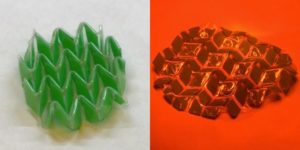Aug 27 2018
Programmable Matter
 I have been reading a lot recently about material science and one thing that has struck me is that we still mostly build our civilization out of traditional materials – concrete, steel, wood, ceramics, paper, leather, and plant fibers, for example. Perhaps the most common modern material is plastic. Look around your home – other than various types of plastic, most of the stuff will be made out of materials we have been using for hundreds or even thousands of years. The notable exception is electronics which often use more recently discovered rare earths.
I have been reading a lot recently about material science and one thing that has struck me is that we still mostly build our civilization out of traditional materials – concrete, steel, wood, ceramics, paper, leather, and plant fibers, for example. Perhaps the most common modern material is plastic. Look around your home – other than various types of plastic, most of the stuff will be made out of materials we have been using for hundreds or even thousands of years. The notable exception is electronics which often use more recently discovered rare earths.
This is not to say that we don’t have a lot of high-tech new materials, they are just mostly too expensive to find in the average home in abundance, so we sill use a lot of wood, metal, rock, and natural fibers. This is why material scientists are always looking for the next plastic, a truly modern material that is inexpensive, easily manufactured, with properties that make it ideal for many applications. Perhaps carbon nanofibers (or nanomaterials more broadly) will be that material, and it has tremendous potential, but we’re not there yet.
Scientists report on a new type of material that I don’t think we will be building our homes out of anytime soon, but does potentially open the door to new applications – programmable matter. The material is liquid crystal elastomers (LCEs), which they are able to program into a specific shape using specific wavelengths of light. The material can then oscillate between two different shapes at different temperatures:
To solve this, the researchers installed a light-activated trigger to LCE networks that can set a desired molecular alignment in advance by exposing the object to particular wavelengths of light. The trigger then remains inactive until exposed to the corresponding heat stimuli. For example, a hand-folded origami swan programmed in this fashion will remain folded at room temperature. When heated to 200 degrees Fahrenheit, however, the swan relaxes into a flat sheet. Later, as it cools back to room temperature, it will gradually regain its pre-programmed swan shape.
This is mostly a proof-of-concept study, but it shows complete reversibility, which is the new advance. It also shows the ability to alter the shape of the material at a large scale. At this preliminary stage, there are two big questions – what is the potential of this material when it matures, and what are the applications? These are always hard questions to answer. But let’s assume that the scientists will be able to fully realize the potential of this material, meaning it is scalable, affordable, and has all the necessary properties. What are the applications?
The authors and press release mention medical devices, robotics, and 3-D printing. At this point, such suggestions are just speculation, which is fine, but likely bears little relationship to any killer apps that may emerge. But it is easy to imagine how having a material that can morph into different pre-programmed shapes can be exploiting for applications like manufacturing, or in certain kinds of devices. Different parts could be programmed to lock together when cooled, for example, and if you need to disassemble them, just heat them up.
The authors also mention morphing at the microscopic scale. This could change the physical properties at the surface of a material – such as making a surface go from smooth to rough or even sticky. This could change the optical properties of matter, which opens up an entirely new arena of possibilities. Perhaps (just riffing here) really small zoom lenses, for example.
Because we are on the other side of the digital revolution, anything potentially programmable means they can be controlled by our powerful computers and increasingly sophisticated software. At the fully-mature end of this tech, we may have the ability to turn sheets of raw material into whatever shape you want, even with multiple and moving parts, simply by shining specific frequency and intensity light in the correct pattern, determined by a ridiculously complex AI computer algorithm.
You could also have a robot with programmable attachments – a real multi-tool that can be whatever it needs to be.
This is a lot of extrapolation from this one study, but it is interesting to consider the potential of a genuinely new material feature, the ability to be programmed into a specific shape, and to morph between at least two distinct shapes.
As always, it will likely take 10-20 years (or more) before we know if this is the next plastic, or just another in a long line of unrealized hype.






